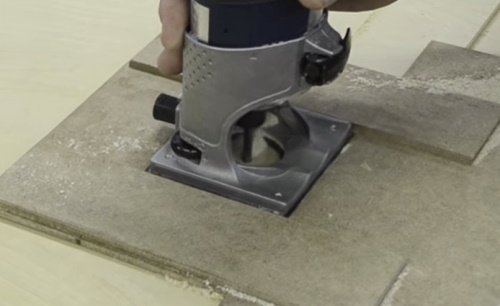
Question: How Do I Set the Correct Router Depth-of-Cut for Joints?
I have trouble setting the correct depth-of-cut on my router.
For decorative cuts like ROUNDOVERS and ogees I do okay, but when adjusting for mortises, tenons, tongues and grooves, and other joints, I have a terrible time.
What can I do about this?
Contents
Answer
Off all the things involved in a router set-up, the depth-of-cut is the most troublesome.
There are at least three reasons for this.
Reasons for the Difficulty in Setting Up Depth-of-Cut
One problem relates to how well you can measure; another is our inability to locate the end of the cutter with respect to the baseplate; and the third problem is in the depth changing mechanism itself.
The Importance of Accuracy in Joinery
As you point out, the necessary cutter depth for a decorative cut is largely an estimation of just what looks right, and usually a measurement is not required.
Joinery is another matter.
A joint that is sloppy is a problem.
Control of the correct and precise depth-of-cut is essential for good joinery.
Successful router joinery can be accomplished in at least two ways.
The Cut and Fit Method
One way is to estimate and then cut and fit.
With this approach no measuring is required.
I do most of my joinery with this approach.
I always use a scrap of equivalent thickness and width (to that of the actual project material) for my test (calibration) cuts.
I do measure the net length and cross section of the lumber I use, but none of the router depths of cut or fence or edge-guide settings are measured.
I just cut, test, fit, and adjust the fence or cutter height by “eyeball” as necessary.
A good fit is one that is not a “hammer fit”, or a “rattle fit”; the joint simply slips home: a “slip fit”.
You can do joinery by measuring, but in my view it’s more difficult and more expensive.
Good joinery and slip-fits in particular are fit to tolerances of a few thousandths of an inch.
A sliding dovetail for example, will rattle loose if there is much more than 3 or 4 thousandths of slop.
Measuring to the nearest one-thousandth, a necessity in this case, requires a well made caliper or micrometer.
One’s touch is also important as is the quality of the measured surface.
Wood is not smooth like a milled piece of steel, and two to four thousandths of surface roughness is typical.
What I’m suggesting here is that one can acquire the skills of fitting by measurement, but that the time might be better spent in learning to cut and fit.
In the final analysis you’ve got to “fit” after measuring and cutting anyway!
Knowing Where the End of the Cutter Is
The second problem I’ve found in setting the correct depth-of-cut is knowing where the end of the cutter is with respect to the baseplate or the router tabletop.
Setting the depth-of cut is usually done in two stages.
In the first stage you lower the cutter to the work surface and lock the motor in this position.
This is the zero position.
To complicate matters, when the cutter is zeroed it will probably penetrate, or emboss, the work surface five to ten thousandths such that the true zero is quite uncertain.
A direct gauge measurement of the tool bit’s extension is a possible solution, but tabletops and baseplates are not flat enough for consistent readouts.
Given ten metrologists (scientists who study measurement) the same gauge and router-bit extension and I’ll bet you get ten different measurements.
The bottom of the cutter is also quite difficult to reference from since it has been relieved for chip clearance, and one flute may extend further than the other.
Error in the Router Itself
Finally, there is plenty of slop and error in most of the depth adjusters in all routers.
In addition, the position of a bit is slightly different when referenced in a locked-up motor (be it plunge or fixed base) or when the motor clamp is relaxed.
This is as it should be since in order for a motor to move on its plunge tubes or in its base casting it needs some clearance.
This backlash, as it is called, can also be found in the motor locks themselves.
So, I’m not surprised you’re having trouble finding the depth-of-cut on your router.
A General Strategy for Getting Accurate Cuts
I think your best strategy for getting accurate cuts with the router is as follows:
1. Cut and fit whenever possible.
2. If you’d like the router to be as much help as possible use the zeroable small Bosch plunge routers when plunging or the 7518 or 7519 Porter Cable routers when you need a fixed-base tool.
3. And if you must know the depth-of-cut precisely, resolve the measurement by subtraction; that is, measure the net thickness of the workpiece, and the remaining thickness of the milled section of the work, then subtract to find the depth-of-cut.
Also, use a precision caliper from Brown and Sharpe, Mitutoyo, Starrett, or another industrial-grade manufacturer.

